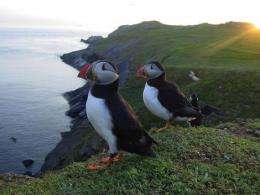Puffins on land. Photo: Chris Perrins.
(PhysOrg.com) -- Individual Atlantic puffins 'scout out' their own migration routes rather than relying on genetic ‘programming’ or learning routes from a parent, a new study suggests.
The evidence comes from research by a team from Oxford University and Microsoft Research Cambridge which used BAS geolocater tags to track the migration movements of 18 birds: with 8 of these birds being tracked for two consecutive years.
A report of the research appears in this week’s PLoS ONE.
The study found that the birds followed a wide range of different migration routes (suggesting their movements were not genetically predetermined) but that they were not merely random as the same bird followed a similar route each year. Because young puffins leave colonies at night, alone, long before their parents, the idea that they might learn a route directly from others also seems extremely unlikely.
‘We think it’s likely that, before they start breeding, young puffins explore the resources the ocean has to offer and come up with their own individual, often radically different, migration routes,’ said Professor Tim Guilford of Oxford University’s Department of Zoology, who co-led the study. ‘This tendency to explore may enable them to develop a route which exploits all the best food sources in a particular area wherever these might happen to be.’
The team believe this kind of ‘scouting’ for good migration routes could also be used by many other species of birds, especially seabirds – which can choose to stop and feed anywhere on the ocean during their migration.
More information: Guilford T, Freeman R, Boyle D, Dean B, Kirk H, et al. (2011) A Dispersive Migration in the Atlantic Puffin and Its Implications for Migratory Navigation. PLoS ONE 6(7): e21336. doi:10.1371/journal.pone.0021336
Abstract
Navigational control of avian migration is understood, largely from the study of terrestrial birds, to depend on either genetically or culturally inherited information. By tracking the individual migrations of Atlantic Puffins, Fratercula arctica, in successive years using geolocators, we describe migratory behaviour in a pelagic seabird that is apparently incompatible with this view. Puffins do not migrate to a single overwintering area, but follow a dispersive pattern of movements changing through the non-breeding period, showing great variability in travel distances and directions. Despite this within-population variability, individuals show remarkable consistency in their own migratory routes among years. This combination of complex population dispersion and individual route fidelity cannot easily be accounted for in terms of genetic inheritance of compass instructions, or cultural inheritance of traditional routes. We suggest that a mechanism of individual exploration and acquired navigational memory may provide the dominant control over Puffin migration, and potentially some other pelagic seabirds, despite the apparently featureless nature of the ocean.
Provided by Oxford University























